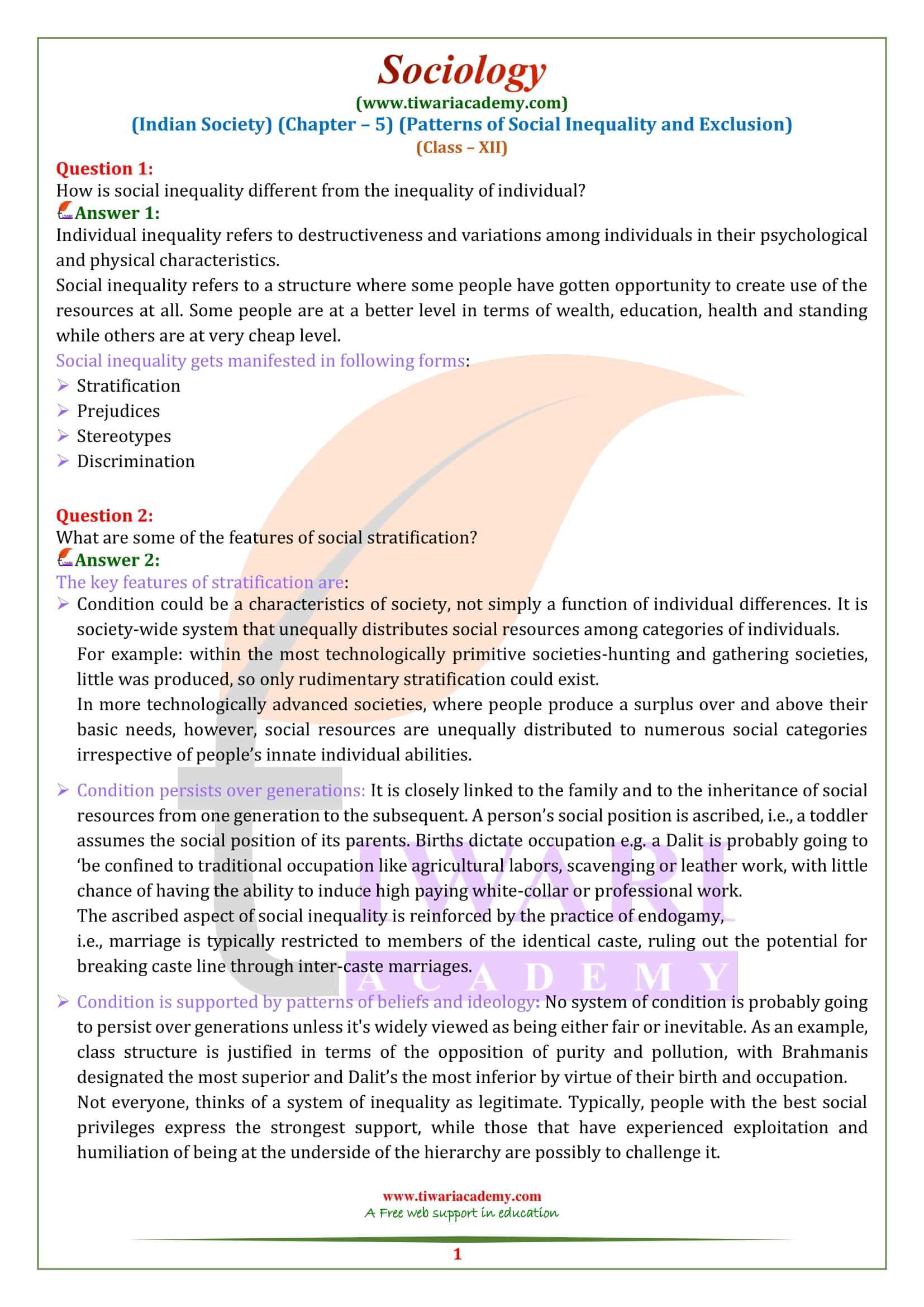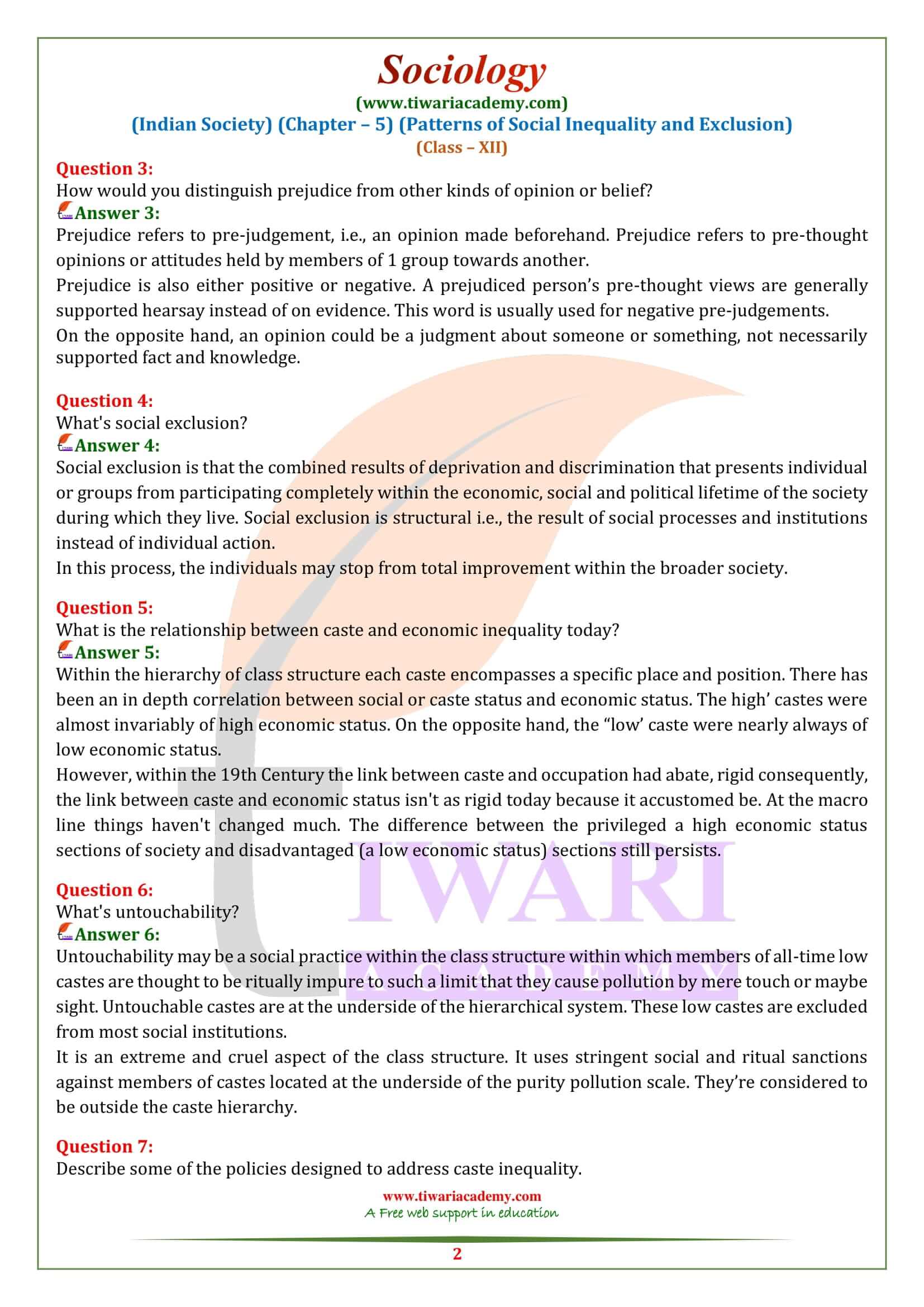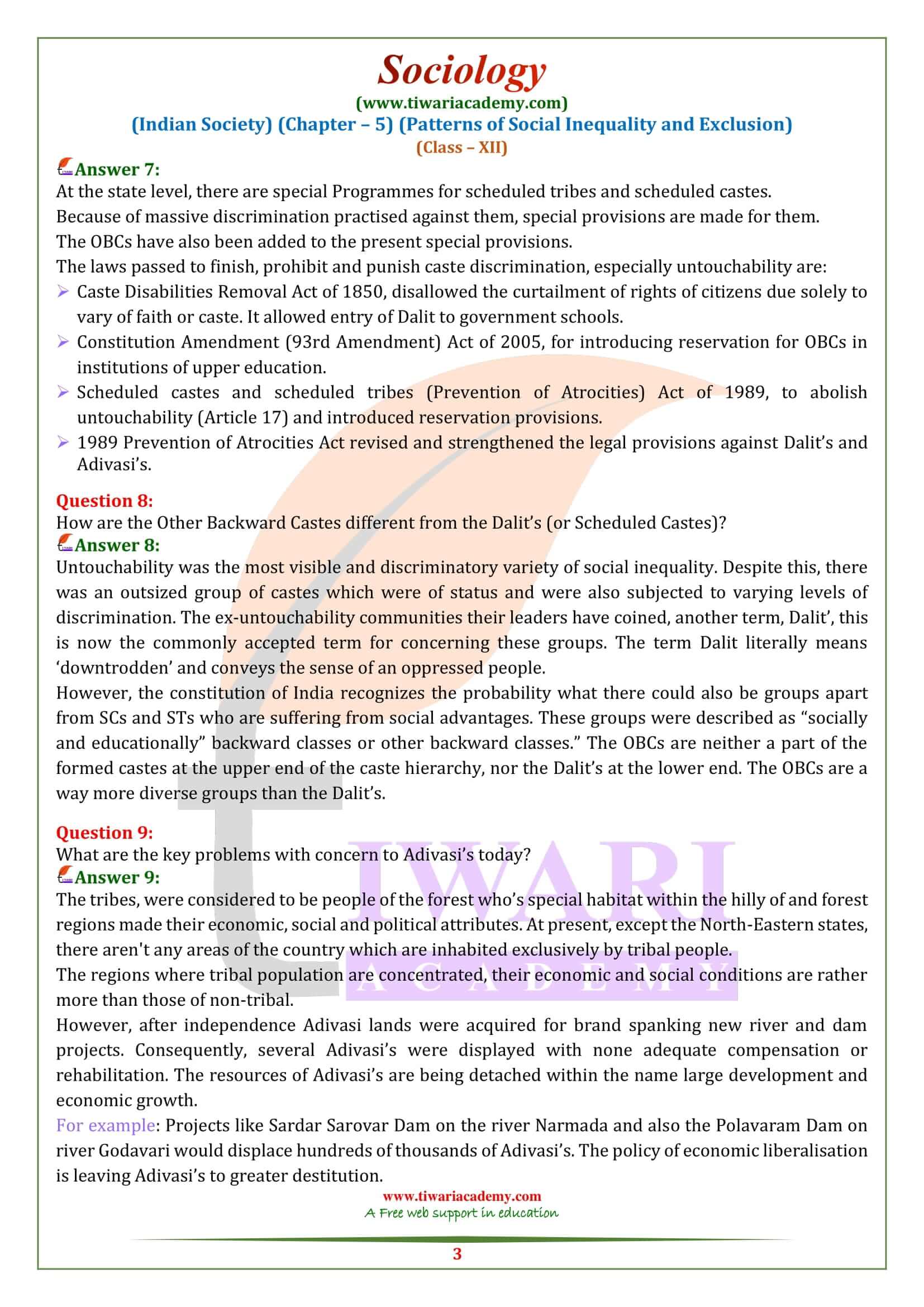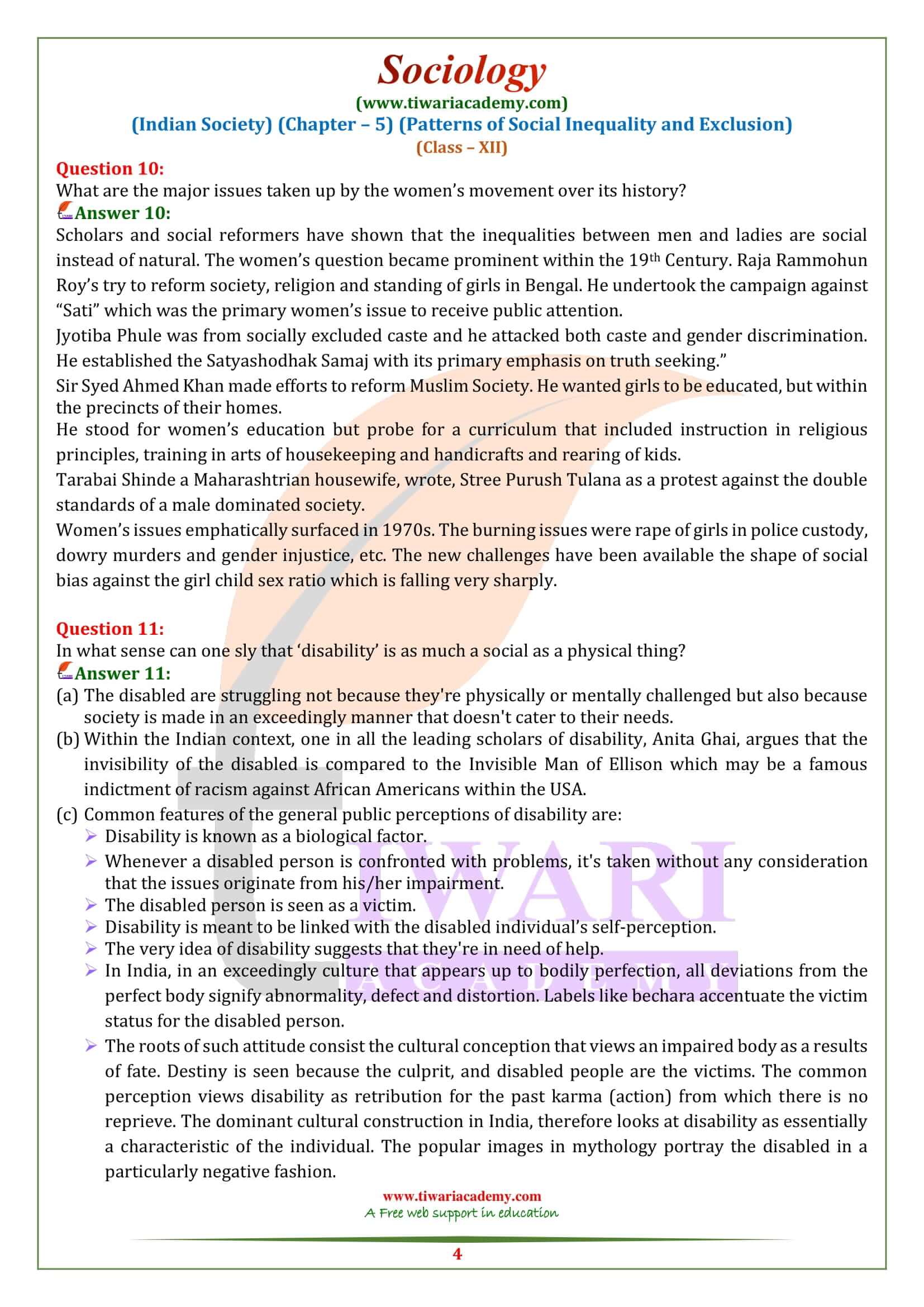NCERT Solutions for Class 12 Sociology Chapter 5 Patterns of Social Inequality and Exclusion updated for new academic session 2025-26. Class 12 part 1 sociology Indian Society chapter 5 MCQ and important question answers are helpful for both state board and CBSE during the exams.
Class 12 Sociology Chapter 5 Patterns of Social Inequality Question Answers
How is social inequality different from the inequality of individual?
Individual inequality refers to destructiveness and variations among individuals in their psychological and physical characteristics.
Social inequality refers to a structure where some people have gotten opportunity to create use of the resources at all. Some people are at a better level in terms of wealth, education, health and standing while others are at very cheap level.
Social inequality gets manifested in following forms:
- Stratification
- Prejudices
- Stereotypes
- Discrimination
What are some of the features of social stratification?
The key features of stratification are:
Condition could be a characteristics of society, not simply a function of individual differences. It is society-wide system that unequally distributes social resources among categories of individuals.
For example: within the most technologically primitive societies-hunting and gathering societies, little was produced, so only rudimentary stratification could exist.
In more technologically advanced societies, where people produce a surplus over and above their basic needs, however, social resources are unequally distributed to numerous social categories irrespective of people’s innate individual abilities.
Condition persists over generations: It is closely linked to the family and to the inheritance of social resources from one generation to the subsequent. A person’s social position is ascribed, i.e., a toddler assumes the social position of its parents. Births dictate occupation e.g. a Dalit is probably going to ‘be confined to traditional occupation like agricultural labors, scavenging or leather work, with little chance of having the ability to induce high paying white-collar or professional work.
The ascribed aspect of social inequality is reinforced by the practice of endogamy, i.e., marriage is typically restricted to members of the identical caste, ruling out the potential for breaking caste line through inter-caste marriages.
Condition is supported by patterns of beliefs and ideology: No system of condition is probably going to persist over generations unless it’s widely viewed as being either fair or inevitable. As an example, class structure is justified in terms of the opposition of purity and pollution, with Brahmanis designated the most superior and Dalit’s the most inferior by virtue of their birth and occupation.
Not everyone, thinks of a system of inequality as legitimate. Typically, people with the best social privileges express the strongest support, while those that have experienced exploitation and humiliation of being at the underside of the hierarchy are possibly to challenge it.
How would you distinguish prejudice from other kinds of opinion or belief?
Prejudice refers to pre-judgement, i.e., an opinion made beforehand. Prejudice refers to pre-thought opinions or attitudes held by members of 1 group towards another.
Prejudice is also either positive or negative. A prejudiced person’s pre-thought views are generally supported hearsay instead of on evidence. This word is usually used for negative pre-judgements.
On the opposite hand, an opinion could be a judgment about someone or something, not necessarily supported fact and knowledge.
What’s social exclusion?
Social exclusion is that the combined results of deprivation and discrimination that presents individual or groups from participating completely within the economic, social and political lifetime of the society during which they live. Social exclusion is structural i.e., the result of social processes and institutions instead of individual action.
In this process, the individuals may stop from total improvement within the broader society.
What is the relationship between caste and economic inequality today?
Within the hierarchy of class structure each caste encompasses a specific place and position. There has been an in depth correlation between social or caste status and economic status. The high’ castes were almost invariably of high economic status. On the opposite hand, the “low’ caste were nearly always of low economic status.
However, within the 19th Century the link between caste and occupation had abate, rigid consequently, the link between caste and economic status isn’t as rigid today because it accustomed be. At the macro line things haven’t changed much. The difference between the privileged a high economic status sections of society and disadvantaged (a low economic status) sections still persists.
What is untouchability?
Untouchability may be a social practice within the class structure within which members of all-time low castes are thought to be ritually impure to such a limit that they cause pollution by mere touch or maybe sight. Untouchable castes are at the underside of the hierarchical system. These low castes are excluded from most social institutions.
It is an extreme and cruel aspect of the class structure. It uses stringent social and ritual sanctions against members of castes located at the underside of the purity pollution scale. They’re considered to be outside the caste hierarchy.
How are the Other Backward Castes different from the Dalit’s (or Scheduled Castes)?
Untouchability was the most visible and discriminatory variety of social inequality. Despite this, there was an outsized group of castes which were of status and were also subjected to varying levels of discrimination. The ex-untouchability communities their leaders have coined, another term, Dalit’, this is now the commonly accepted term for concerning these groups. The term Dalit literally means ‘downtrodden’ and conveys the sense of an oppressed people.
However, the constitution of India recognizes the probability what there could also be groups apart from SCs and STs who are suffering from social advantages. These groups were described as “socially and educationally” backward classes or other backward classes.” The OBCs are neither a part of the formed castes at the upper end of the caste hierarchy, nor the Dalit’s at the lower end. The OBCs are a way more diverse groups than the Dalit’s.
What are the important sub topics in class 12 sociology chapter 5?
The main topics of class 12 sociology chapter 5 are as follow:
- Social inequality
- Social Stratification
- Prejudice
- Stereotype
- Discrimination
- Social Exclusion
What are the three types of capital discussed in chapter 5 of class 12 sociology?
Economic Capital, Social capital and Cultural capital are the main three types of capital which are being discussed in chapter 5 of class 12 sociology NCERT book.
In class 12 sociology chapter 5 we will study the following:
i. Caste disability Removal Act – 1850
ii. Abolition of Untouchability
iii. Prevention of atrocitie Act – 1889
iv. Constitutional Amendment Act – 2005
The above topics are law based as can be inferred from tittles itself.






